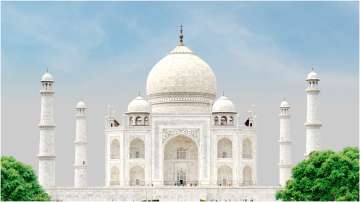Taj Mahal Controversy: All you need to know about the iconic 'monument of love' built by Shah Jahan
Taj Mahal was built by Mughal emperor Shah Jahan in the memory of his third wife Mumtaz Mahal in 1648 AD. The beautiful monument built in white marble is one of the 7 wonders of the world.

A petition has been filed in the Allahabad High Court, seeking a fact-finding inquiry into the "history" of the Taj Mahal, and also opening of the doors of its "22 rooms" to see "the truth, whatever it is". The Mughal-era monument is protected by the Archaeological Survey of India. Several right-wing outfits have claimed in the past the Taj Mahal was a Lord Shiva temple.
The writ petition was filed at the High Court on May 7, 2022. It will first be processed by the registry of the Lucknow bench and then taken up for hearing. As this is a developing issue, we take a look at what Taj Mahal's history is all about.
Read: Zambian emerald breaks Guinness World Records for the largest high-quality emerald ever discovered
Who built Taj Mahal?
Shah Jahan was the fifth Mughal ruler after Babur, Humayun, Akbar, and Jahangir. He is considered to be one of the greatest Mughals and his reign has been called the Golden Age of Mughals. Shah Jahan erected many splendid monuments during his life span, the most famous of which is the Taj Mahal at Agra.
Read: What does an octopus eat? For a creature with a brain in each arm, whatever’s within reach
When was Taj Mahal built?
The Taj Mahal is actually an integrated complex of structures with the white domed marble mausoleum being its most significant component. The construction of the Taj Complex began about 1631 AD. The principal mausoleum was completed in 1648 AD by employing thousands of artisans and craftsmen, whereas, the outlying buildings and gardens were finished five years later in 1653 AD.
How many people built Taj Mahal?
In the Islamic world at that time, the credit for a building design was usually given to its patron rather than its architects. It is believed that a labour force of about twenty thousand workers was recruited from across Northern India was employed to built Taj Mahal. Sculptors from Bukhara, calligraphers from Syria and Persia, inlayers from southern India, stone cutters from Baluchistan, a specialist in building turrets, another who carved only marble flowers were part of the thirty-seven men who formed the creative unit.
Did Shah Jahan chop off the hands of Taj Mahal workers?
The claim – Shah Jahan chopped the hands of those who built the Taj Mahal – is a well-known urban myth. Shah Jahan built a vast settlement called Taj Ganj to house the workers employed to build the Taj Mahal. The settlement still exists today. The claim that he chopped off the hands of his workers stands in contrast with the emperor taking care of his thousands of workers. In multiple findings, this claim has been dismissed as an urban legend. There is no evidence of this claim too.
The popularity of Taj Mahal
Taj Mahal was named a UNESCO World Heritage Site in 1982. As a national symbol of India, it welcomes millions of visitors each year. It is also one of the 'seven wonders of the world'.
Theories on Taj Mahal
-- Taj Mahal is known as the 'monument of love'. Shah Jahan built it in memory of his third wife Mumtaz Mahal, a Muslim Persian princess. She died while accompanying her husband in Burhanpur in a campaign to crush a rebellion after giving birth to their 13th child. The death so crushed the emperor that all his hair and beard were said to have grown snow white in a few months. When Mumtaz Mahal was still alive, she extracted four promises from the emperor: first, that he build the Taj; second, that he should marry again; third, that he be kind to their children; and fourth, that he visit the tomb on her death anniversary. However, due to ill health and being under house arrest by his own son and successor to the throne, Aurangzeb, barred Shah Jahan from continuing to keep the last promise. The graves of Shah Jahan and Mumtaz lie together in a crypt in the Taj Mahal.
-- One of the theories is that the Taj Mahal is not Indian. Many Westerners found themselves shocked that the Indian culture could produce such good architecture.
-- Many believe that there was to be an identically designed 'black' Taj Mahal across the Yamuna river for Shah Jahan to be buried. This myth was started by Jean-Baptiste Tavernier, a visitor to Agra in 1665, but its flatly unproven.